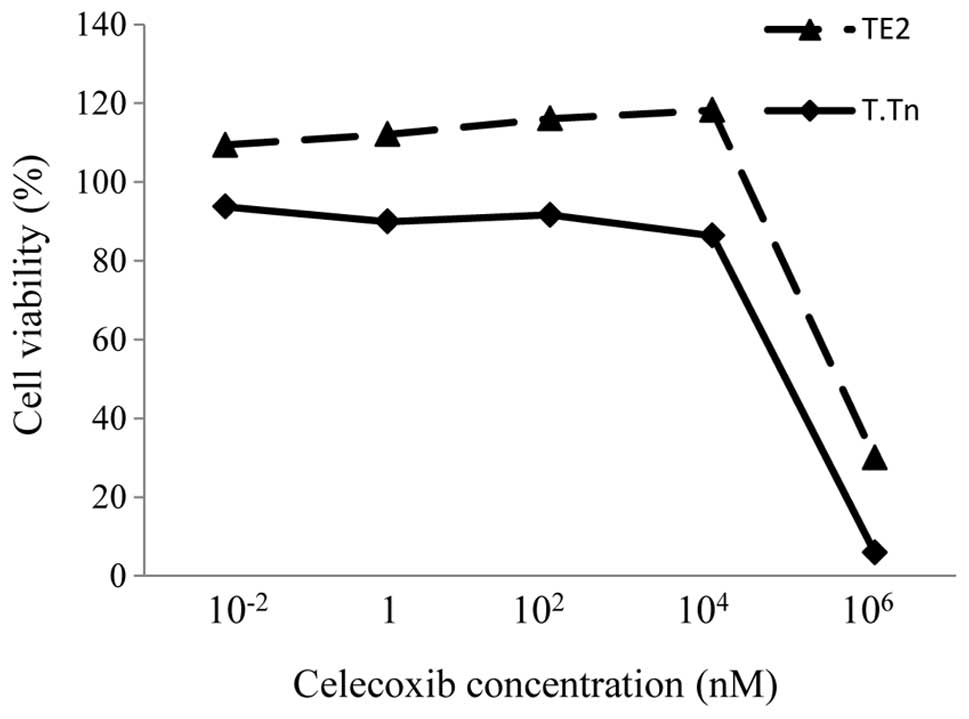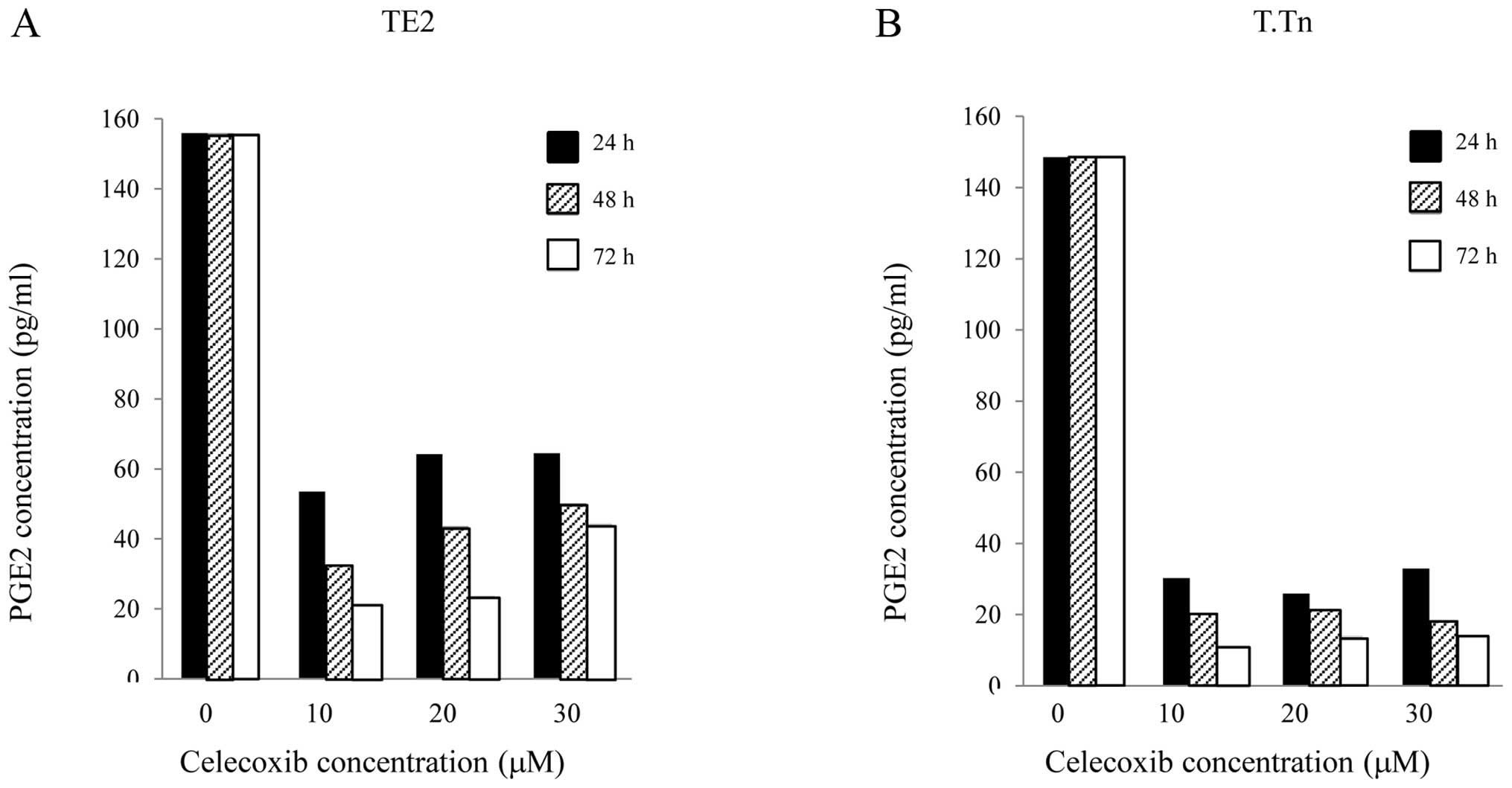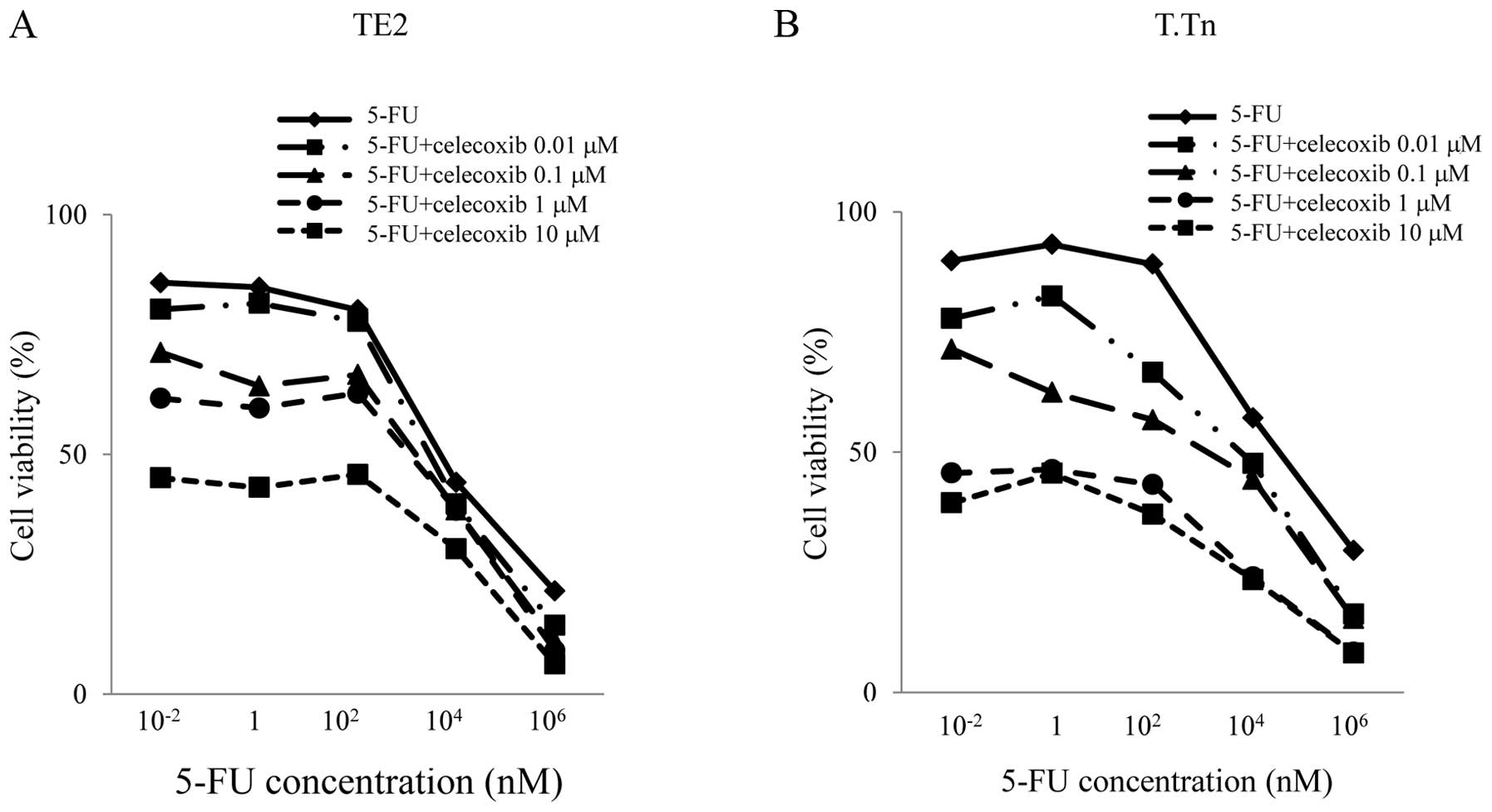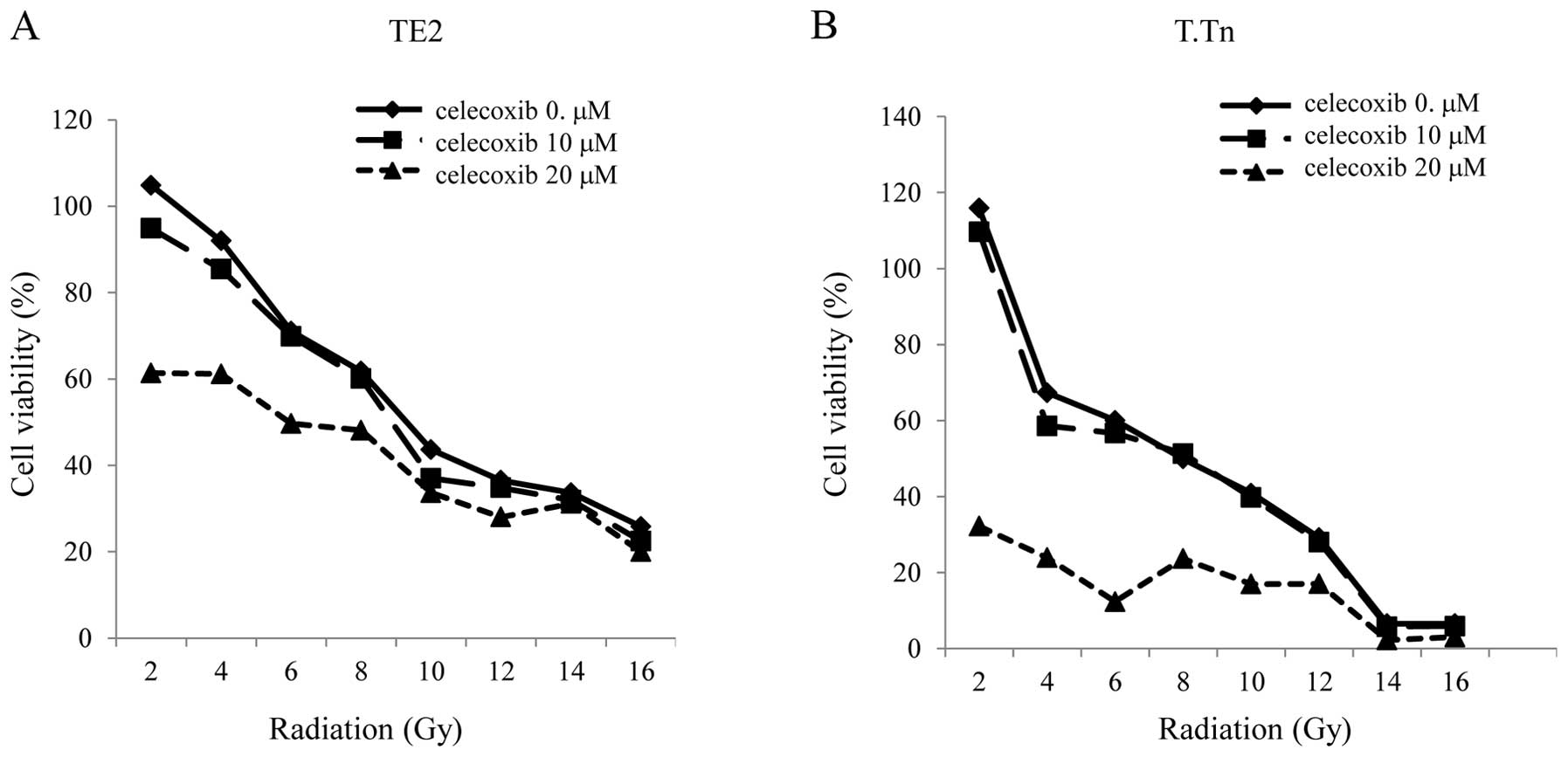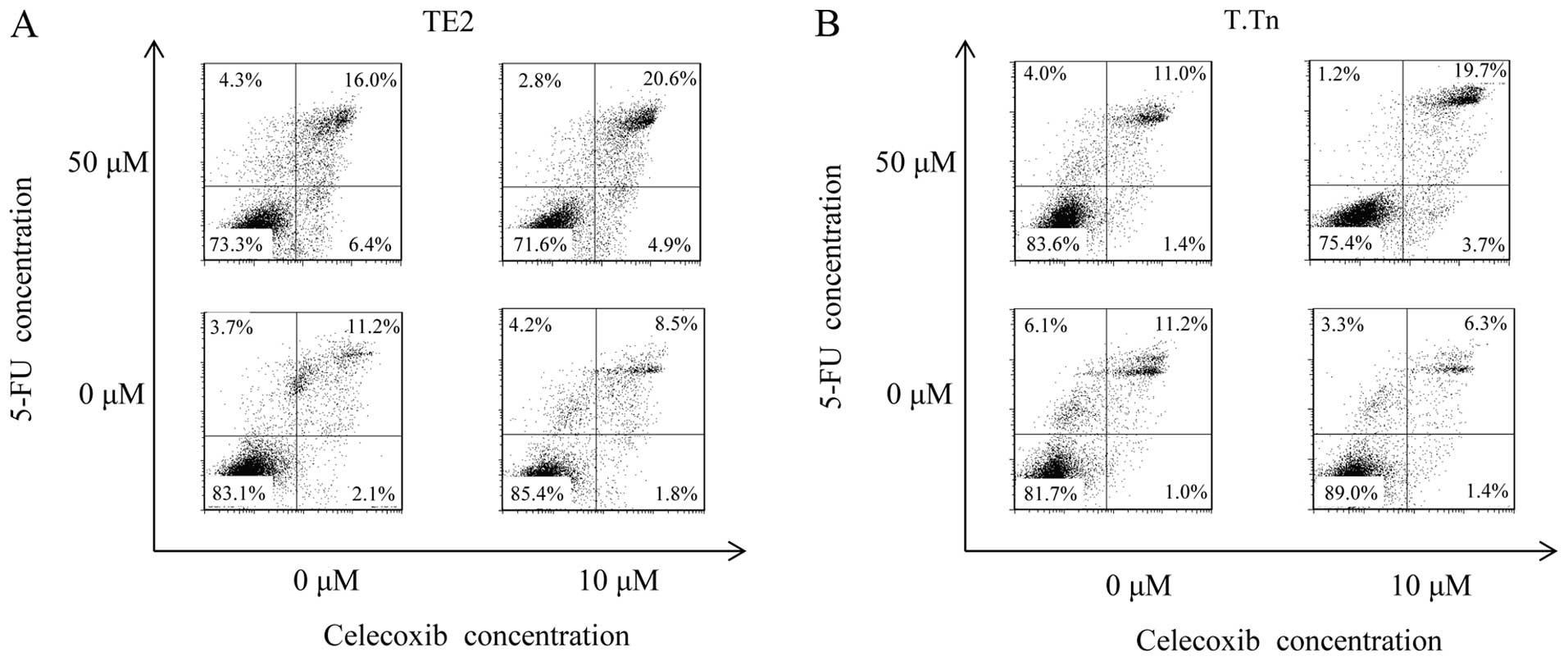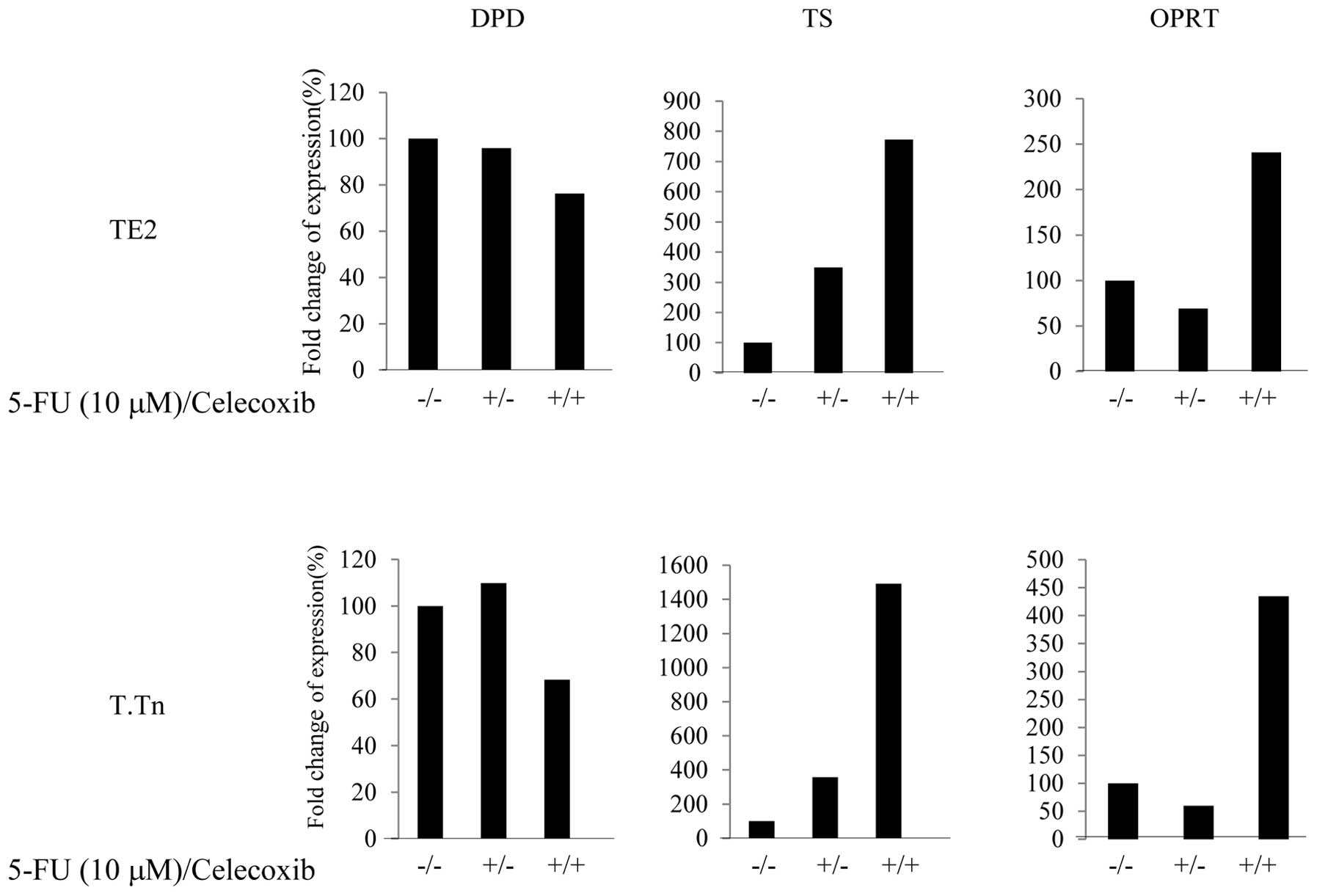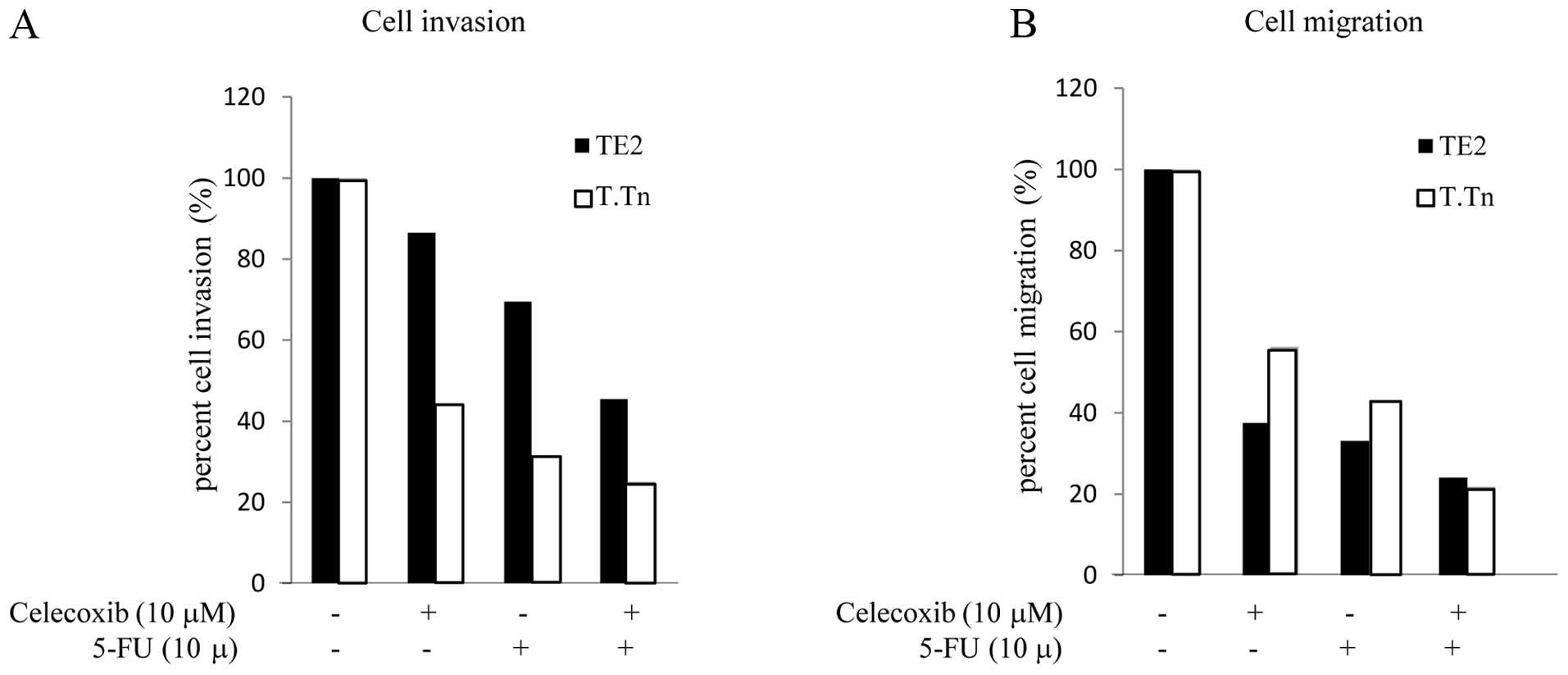A COX-2 inhibitor enhances the antitumor effects of chemotherapy and radiotherapy for esophageal squamous cell carcinoma
- Authors:
- Published online on: February 14, 2014 https://doi.org/10.3892/ijo.2014.2300
- Pages: 1146-1152
Abstract
Introduction
Esophageal cancer is a highly aggressive neoplasm with a very poor prognosis. The primary treatments of esophageal cancer include surgery, chemotherapy and radiotherapy (1). In patients with locoregional esophageal cancer, surgical resection provides the best chance for a cure. However, in inoperable cases, chemoradiotherapy (CRT) is extremely important, although the 5-year survival rate remains poor (1,2). Therefore, the most important issue is how to improve the therapeutic effects of treatment.
Cyclooxygenase (COX), which consists of two isoforms, COX-1 and COX-2, is a key enzyme that catalyzes the transformation of arachidonic acid to prostaglandins (3). It is well known that COX-1 is expressed in many tissues and is responsible for various physiological functions (3,4). On the other hand, recent studies have demonstrated that COX-2 is overexpressed in various malignancies, including pancreatic, gastric, prostate, lung, colon, breast, liver, brain and esophageal cancer (5–10). Recently, it has been reported that the overexpression of COX-2 induced tumor progression and promotes resistance to apoptosis activating various factors (11–13). We previously reported that the overexpression of COX-2 is closely correlated with resistance to chemoradiotherapy (CRT) for esophageal squamous cell carcinoma (ESCC) (14). Therefore, reducing the activity of COX-2 may enhance the antitumor effects of CRT for ESCC (14).
The non-steroidal anti-inflammatory drug (NSAID) celecoxib (a selective COX-2 inhibitor) belongs to the class of diaryl heterocycles and constitutes a potent and specific inhibitor of human COX-2 (15), which is responsible for resistance to apoptosis, tumor growth, increased angiogenesis, tumor invasion and metastasis (15–19).
We evaluated the usefulness of the COX-2 inhibitor celecoxib in combination with treatment including radiation and chemotherapy for ESCC.
Materials and methods
Cell culture and drugs
The esophageal squamous cell lines TE2 and T.Tn were plated in culture bottles and cultured in Dulbecco’s modified Eagle’s medium nutrient mixture (DMEM; Sigma, St. Louis, MO, USA) with 10% fetal bovine serum (FBS) and 5 mmol/l of L-glutamine, and 100 U/ml of penicillin at 37°C in a 5% CO2 atmosphere.
Celecoxib (a COX-2 inhibitor) kindly provided by Compound Transfer, Research and Development Operations, Pfizer Inc., New York, NY, USA, was dissolved in dimethyl sulfoxide (DMSO). 5-Fluorouracil (5-FU) was purchased from Sigma and dissolved in DMEM (5% P/S, 10% FBS).
Viability of cells treated with celecoxib and/or 5-FU
First, the TE2 and T.Tn cell lines were plated in 96-well plates at a density of 3,000 cell/well for 24 h after seeding. Then, the cell lines were cultured with varying concentrations of celecoxib and/or 5-FU for 72 h. Following these treatments, 10 μl/well of the Cell Counting Kit-8 was added, and the cells were incubated for 2 h. Finally, the optical density at 450 nm in the multi-mode micro-plate reader was measured in triplicate. The cell viability was calculated using the following equation: cell viability (%) = (A experimental group - A control group)/A control group × 100%.
Drug treatment and irradiation
First, the cells were plated in 96-well plates and treated with varying concentrations of celecoxib for 72 h. The cells were cultured after irradiation, combined with celecoxib treatment for five days. After these treatments, 10 μl/well of the Cell Counting Kit-8 was added, and the cells were incubated for 2 h. Finally, the optical density at 450 nm in the multi-mode micro-plate reader was measured in triplicate.
Observation of apoptosis using flow cytometry
A total of four groups, including the control and experimental groups, were evaluated for apoptosis. When the cells grew to the logarithmic phase, they were treated with 50 μmol/l of 5-FU, or 10 μmol/l of celecoxib, or both for 48 h. After this treatment, the cells were digested with 0.25% trypsin to create single cell suspensions. After the cell density was adjusted to 5×105/100 μl of binding buffer, 5 μl of Annexin V-FITC and 5 μl of propidium iodide were added and the mixture was gently vortexed followed by incubation for another 15 min at room temperature in the dark. After this procedure, a volume of 400 μl of binding buffer was added to each tube and prepared for an analysis of apoptosis using flow cytometry within 1 h.
Measurement of the mRNA levels using real-time reverse transcription polymerase chain reaction (RT-PCR) for dihydropyrimidine dehydrogenase (DPD) and orotate phosphoribosyl transferase (OPRT)
The cells were incubated for 48 h with either celecoxib or 5-FU and/or both. The RNA was extracted using TRIzol® Reagent (Invitrogen, Carlsbad, CA, USA), and 1 μg of RNA was transcribed to cDNA using a High-Capacity RNA-to-cDNA kit (Applied Biosystems, Foster City, CA, USA). The resulting 1 μl of cDNA was amplified via PCR. The sequence and size of the expected PCR products were as follows: DPD (sense, 5′-AGGACGCAAGGAGG GTTTG-3′; antisense, 5′-GTCCGCCGAGTCCTTACTGA-3′; 118 bp), OPRT (sense, 5′-TAGTGTTTTGGAAACTGTTG AGGTT-3′; antisense, 5′-CTTGCCTCCCTGCTCTCTGT-3′; 91 bp) and β-actin (sense, 5′-TCATGAAGATCCTCAC CGAG-3′; antisense, 5′-TTGCCAATGGTGATGACCTG-3′; 190 bp). The PCR conditions consisted of 40 cycles of 95°C for 30 sec, 95°C for 5 sec, 60°C for 10 sec. This assay was performed in triplicate.
Cell migration and invasion assay
A membrane invasion culture system (BD BioCoat™ Matrigel™ Invasion Chamber, Tokyo, Japan) was used to quantify the degree of cell invasion and migration. The cells were incubated for 72 h with either celecoxib or 5-FU or both. A total of 4×104 cells in 500 μl of serum-free medium were added to the upper chamber of the Transwell-precoated Matrigel membrane filter inserts with 8-μm pores in 24-well tissue culture plates. A total of 750 μl of 10% FBS medium was added to the lower chamber. Thereafter the cells were incubated for 22 h at 37°C. Following incubation, the non-invading cells were mechanically removed from the upper surface of the membrane. Subsequently, the cells were fixed and stained with 100% methanol and 1% Toluidine, blue or 0.25% crystal violet. Next, the membrane was washed with distilled water to remove excess staining and dried. The cells on the lower surface were counted manually under a microscope. This assay was performed in triplicate.
ELISA for prostaglandin E2
The cells were incubated for 24, 48 and 72 h with celecoxib (0, 10, 20, 30 μM). The PGE2 levels were measured using an enzyme-linked immunosorbent assay (ELISA) as described by PGE2 Prostaglandin E2, EIA Kit - Monoclonal (Cayman Chemical Company, Ann Arbor, MI, USA) according to the manual. The concentrations were determined following absorbance measurement with a micro-plate reader (micro-plate manager version 6.0, Bio-Rad, Tokyo, Japan). This assay was performed in triplicate.
Results
Cytotoxicity of celecoxib in the TE2 and T.Tn cells
The TE2 and T.Tn cells were treated with different concentrations of celecoxib for 72 h, and the cell viability was evaluated. There was no toxicity in the cells treated with concentrations 10−2 and 104 nM (Fig. 1). However, when the concentration increased to 106 nM, the cell viability was strongly reduced. This finding shows that celecoxib itself does not exhibit any antitumor effects under the normal range of concentrations.
Serum levels of PGE2 in the TE2/T.Tn cells following treatment with celecoxib
In this study, the PGE2 levels in the TE2 and T.Tn cells were determined using ELISA. As shown in Fig. 2, celecoxib exhibited obvious inhibitory effects on PGE2 in the TE2 and T.Tn cells during the growth process, especially as the drug exposure time was extended, compared with the normal growth of cancer cells. The production of PGE2 was also significantly reduced.
Cytotoxicity of TE2 and T.Tn to 5-FU and celecoxib
To investigate whether celecoxib can potentiate the cytotoxic effects of 5-FU in the two cell lines, cytotoxic assays were conducted. As shown in Fig. 3, in the TE2 cell line, no antitumor effects were observed between 0 and 100 nM of 5-FU treatment alone. However, when adding celecoxib, the antitumor effects were enhanced in a celecoxib concentration-dependent manner. This indicated that celecoxib enhances the antitumor effects of 5-FU even when the concentration of 5-FU is low.
Viability of TE2/T.Tn cells treated with radiation and celecoxib
The TE2 and T.Tn cells were cultured with celecoxib in addition to receiving irradiation, after which the cell viability was evaluated. There was enhancement of the antitumor effects in the TE2 cells cultured with the COX-2 inhibitor at 20 μM compared to that observed in the cells exposed to radiation alone. The discrepancy in cell viability between the radiation alone group and the radiation plus celecoxib group increased in the range of lower doses of radiation, especially after the radiation. The same result was found in the T.Tn cells, at an even higher level than that observed in the TE2 cells (Fig. 4).
Apoptosis induced by celecoxib and 5-FU
The Annexin V FITC/PI double-labeling method was performed to detect apoptotic cells. As shown in Fig. 5, the flow cytometry analysis demonstrated no differences in the Annexin V+PI+ cell population between the TE2 cells cultured with celecoxib alone (10 μM) (8.54%) and the control group (11.2%). On the other hand, a significant increment in the population of apoptotic cells was observed when the cells were cultured with both celecoxib and 5-FU (20.6%). The same result was found in the T.Tn cells at an even higher level than that observed in the TE2 cells.
Expressions of OPRT and DPD following treatment with celecoxib
5-FU was metabolized to the nucleotide level, and DPD and OPRT are important metabolic enzymes for 5-FU. As shown in Fig. 6, the expression of DPD, a degenerative enzyme for 5-FU, was lower (70%) in the TE2 and T.Tn cells than in the control group when treated with combination of celecoxib and 5-FU. With regard to the OPRT expression, an approximately 2.5-fold increase was observed in the TE2 cells and an approximately 5-fold increase was observed in the T.Tn cells. Based on these data, celecoxib reduces the degeneration of 5-FU and increases the metabolism of 5-FU with stronger antitumor effects by modifying 5-FU-related enzymes, accordingly. This mechanism can be used to explain the effects of celecoxib in enhancing the antitumor effects of 5-FU.
Effects of celecoxib on the cell invasion and migration potential
The cell migration and invasion activity in the TE2 and T.Tn cells following treatment with 5-FU and celecoxib is shown in Fig. 7. In the TE2 cells, treated with celecoxib alone, the cell invasion activity was 86.5% compared to that observed in the control cells. When cultured with 5-FU alone, the cell invasion activity was reduced to 69.5% compared to that observed in the controls. However, when cultured with both celecoxib and 5-FU, the inhibition rate was markedly reduced to 45.4% (Fig. 7A). This trend was also observed in the T.Tn cells (celecoxib alone, 44.2%; 5-FU alone, 31.3%; combination group, 25.1%). Next, in order to quantify the cell migration levels, the cells were treated with either 5-FU or celecoxib, or both (Fig. 7B). In the T.Tn cells, when treated with celecoxib alone, the migration activity was reduced to 56.3%. When treated with 5-FU alone, the invasion rate was 43.1%. However, when cultured with both celecoxib and 5-FU, the migration activity was markedly reduced to 21.8% compared to that observed in the control group. This trend was also observed in the TE2 cells (celecoxib alone, 37.5%; 5-FU alone, 33.1%; combination group, 24%). These results indicated that celecoxib enhances the inhibition of both the invasion and migration activity induced 5-FU.
Discussion
The long-term use of non-steroidal anti-inflammatory drugs (NSAIDs) can reduce the risk of cancer and inhibit the growth of various cancers, including squamous cell carcinoma (7). The primary target of NSAIDs is COX-2, which is responsible for resistance to apoptosis, tumor growth, increased angiogenesis, tumor invasion and metastasis (16,17). Elevated levels of the COX-2 expression have been found in human cancers (5–10), and appear to be involved in the development of cancer via PGE2 production (7,20–23). In addition, COX-2 overexpression is often associated with a shorter time to progression and/or overall survival (24). The function of COX-2 in tumor progression has been recently elucidated. To date, at least five mechanisms by which COX-2 contributes to tumorigenesis and the malignant phenotype of tumor cells have been identified, including inhibition of apoptosis, increased invasiveness, increased angiogenesis, modulation of inflammation/immune-suppression and conversion of procarcinogens to carcinogens (5). Research regarding the role of COX-2 in cancer prevention and tumor progression inhibition is ongoing. With respect to treatment effects, the overexpression of COX-2 leads to tolerance of treatments such as chemotherapy and chemoradiotherapy, as we previously reported (14).
5-Fluorouracil (5-FU) is one of the most common and effective clinical chemotherapy medications for the treatment of digestive tract tumors, with a specific set of effects. The primary mechanism of action consists of interfering with DNA synthesis and mRNA translation (25). 5-FU metabolism is primarily regulated by enzymes, such as DPD and OPRT (25–27). The rate-limiting enzyme of 5-FU catabolism is DPD, as more than 80% of administered 5-FU is catabolized by DPD (26). Measuring the level of DPD activity can be used as a screening procedure to identify patients with DPD deficiency, before the start of treatment with 5-FU (27). The metabolized form of 5-FU is directly converted by OPRT, and further dephosphorylated to generate the active metabolite fluorodeoxyuridine monophosphate (FdUMP) which binds to the nucleotide-binding site of TS and forms a stable ternary complex with TS and 5,10-methylenetetrahydrofolate(5,10-CH2-THF), leading to DNA damage (25).
The present study demonstrated that COX-2, was upregulated in the 5-FU resistant esophageal cancer cell lines. Although celecoxib, a COX-2 inhibitor, exhibited very slight anticancer effects in the TE2/T.Tn cells, stronger anticancer effect was observed following changes in the DPD and OPRT levels in the 5-FU resistant esophageal cancer cell lines.
In this study, celecoxib inhibited the COX-2 activity, leading to a reduction in the PGE2 levels in the cancer cells. This indicates that B-cell lymphoma-2 (BCL-2), matrix metal-loproteinase-2 (MMP-2), epidermal growth factor receptor (EGFR), endothelial growth factor (VEGF) and other factors are restrained by COX-2-PGE2-dependent mechanisms (28–31). However, Elder et al reported no correlations between the sensitivity of colon cancer cell lines to NS-398 and the COX-2 expression or between the addition of PGE2 and the induction of apoptosis (32). This discrepancy may represent differences between the cells analyzed by different investigators and the types of NSAIDs used. On the other hand, celecoxib upregulates the OPRT expression and downregulates the DPD expression, which may increase the antitumor effects of 5-FU and can inhibit the growth of tumor cells or increase the apoptosis of cancer cells and inhibit cancer cell migration and invasion. Consequently, the changes in the reduction of the enzyme activity observed in experimental systems exhibit good relationships with the enhancement of the antiproliferative potency of 5-FU. However, thus far, it is unclear through which factors and pathways COX-2 inhibitors can change the expressions of DPD and OPRT mRNA. In their in vivo research, Irie et al reported that celecoxib (a selective COX-2 inhibitor) synergistically potentiates the antitumor effects of 5-FU in colon cancer cells in an IFN-γ-dependent manner (33).
In addition, we tested the effects of combination therapy with celecoxib and radiation in TE2 and T.Tn cells. The results showed that the effects of combination therapy are stronger than those of radiotherapy alone. Our experimental results are supported by those of Kuipers et al (34). Previous studies have revealed that these effects are due to cell cycle arrest. Radiosensitivity enhancement using a COX-2 inhibitor is achieved through COX-2-dependent cell cycle regulation (35) and primarily results from the inhibition of ionizing radiation-induced G2 arrest (36). It has also been suggested that these effects are likely due to the inhibition of the radio-protective effects of prostaglandins (37). Other mechanisms have also been elucidated. COX-2 inhibitors contribute to the enhancing antitumor effects via the activation of caspase-3 and caspase-8 or the inhibition of DNA repair processes (38,39).
In conclusion, resistance to cancer treatment can be decreased by COX-2 inhibitors. COX-2 inhibitors are useful enhancers of antitumor drugs and act as radiosensitizers for radiotherapy for ESCC. Therefore, these drugs may be useful as a component of combination treatment for cancer.
References
|
Pennathur A, Gibson MK, Jobe BA and Luketich JD: Oesophageal carcinoma. Lancet. 381:400–412. 2013. View Article : Google Scholar | |
|
Siersema PD: Esophageal cancer. Gastroenterol Clin North Am. 37:943–964. 2008. View Article : Google Scholar | |
|
Rizzo MT: Cyclooxygenase-2 in oncogenesis. Clin Chim Acta. 412:671–687. 2011. View Article : Google Scholar : PubMed/NCBI | |
|
Smith WL, DeWitt DL and Garavito RM: Cyclooxygenases: structural, cellular, and molecular biology. Annu Rev Biochem. 69:145–182. 2000. View Article : Google Scholar : PubMed/NCBI | |
|
Dempke W, Rie C, Grothey A and Schmoll HJ: Cyclooxygenase-2: a novel target for cancer chemotherapy? J Cancer Res Clin Oncol. 127:411–417. 2001. View Article : Google Scholar : PubMed/NCBI | |
|
Shamma A, Yamamoto H, Doki Y, et al: Up-regulation of cyclooxygenase-2 in squamous carcinogenesis of the esophagus. Clin Cancer Res. 6:1229–1238. 2000.PubMed/NCBI | |
|
Hida T, Yatabe Y, Achiwa H, et al: Increased expression of cyclooxygenase 2 occurs frequently in human lung cancers, specifically in adenocarcinomas. Cancer Res. 58:3761–3764. 1998.PubMed/NCBI | |
|
Dannenberg AJ and Subbaramaiah K: Targeting cyclooxygenase-2 in human neoplasia: rationale and promise. Cancer Cell. 4:431–436. 2003. View Article : Google Scholar : PubMed/NCBI | |
|
Okamura H, Fujiwara H, Umehara S, et al: COX-2 overexpression Induced by gene transfer reduces sensitivity of TE13 esophageal carcinoma cells to 5-fluorouracil and cisplatin. Anticancer Res. 33:537–542. 2013. | |
|
Higashi Y, Kanekura T and Kanzaki T: Enhanced expression of cyclooxygenase (COX)-2 in human skin epidermal cancer cells: evidence for growth suppression by inhibiting COX-2 expression. Int J Cancer. 86:667–671. 2000. View Article : Google Scholar : PubMed/NCBI | |
|
Lucci A, Krishnamurthy S, Singh B, et al: Cyclooxygenase-2 expression in primary breast cancers predicts dissemination of cancer cells to the bone marrow. Breast Cancer Res Treat. 117:61–68. 2009. View Article : Google Scholar : PubMed/NCBI | |
|
Van Nes JG, de Kruijf EM, Faratian D, et al: COX2 expression in prognosis and in prediction to endocrine therapy in early breast cancer patients. Breast Cancer Res Treat. 125:671–685. 2011.PubMed/NCBI | |
|
Hashimoto N, Inayama M, Fujishima M and Shiozaki H: Clinicopathologic significance of expression of cyclooxygenase-2 in human esophageal squamous cell carcinoma. Hepatogastroenterology. 54:758–760. 2007.PubMed/NCBI | |
|
Akutsu Y, Hanari N, Yusup G, et al: COX2 expression predicts resistance to chemoradiotherapy in esophageal squamous cell carcinoma. Ann Surg Oncol. 18:2946–2951. 2011. View Article : Google Scholar : PubMed/NCBI | |
|
Jendrossek V: Targeting apoptosis pathways by Celecoxib in cancer. Cancer Lett. 332:313–324. 2013. View Article : Google Scholar : PubMed/NCBI | |
|
Boolbol SK, Dannenberg AJ, Chadburn A, et al: Cyclooxygenase-2 overexpression and tumor formation are blocked by sulindac in a murine model of familial adenomatous polyposis. Cancer Res. 56:2556–2560. 1996.PubMed/NCBI | |
|
Tsujii M, Kawano S and DuBois RN: Cyclooxygenase-2 expression in human colon cancer cells increases metastatic potential. Proc Natl Acad Sci USA. 94:3336–3340. 1997. View Article : Google Scholar : PubMed/NCBI | |
|
Kwak YE, Jeon NK, Kim J and Lee EJ: The cyclooxygenase-2 selective inhibitor celecoxib suppresses proliferation and invasiveness in the human oral squamous carcinoma. Ann NY Acad Sci. 1095:99–112. 2007. View Article : Google Scholar : PubMed/NCBI | |
|
Dai ZJ, Ma XB, Kang HF, et al: Antitumor activity of the selective cyclooxygenase-2 inhibitor, celecoxib, on breast cancer in vitro and in vivo. Cancer Cell Int. 12:532012. View Article : Google Scholar : PubMed/NCBI | |
|
Soslow RA, Dannenberg AJ, Rush D, et al: COX-2 is expressed in human pulmonary, colonic, and mammary tumors. Cancer. 89:2637–2645. 2000. View Article : Google Scholar : PubMed/NCBI | |
|
Gupta S, Srivastava M, Ahmad N, Bostwick DG and Mukhtar H: Over-expression of cyclooxygenase-2 in human prostate adenocarcinoma. Prostate. 42:73–78. 2000. View Article : Google Scholar : PubMed/NCBI | |
|
Sano H, Kawahito Y, Wilder RL, et al: Expression of cyclooxygenase-1 and -2 in human colorectal cancer. Cancer Res. 55:3785–3789. 1995.PubMed/NCBI | |
|
Hwang D, Scollard D, Byrne J and Levine E: Expression of cyclooxygenase-1 and cyclooxygenase-2 in human breast cancer. J Natl Cancer Inst. 90:455–460. 1998. View Article : Google Scholar : PubMed/NCBI | |
|
De Groot DJ, de Vries EG, Groen HJ and de Jong S: Non-steroidal anti-inflammatory drugs to potentiate chemotherapy effects: from lab to clinic. Crit Rev Oncol Hematol. 61:52–69. 2007.PubMed/NCBI | |
|
Takemura M, Morimura K, Yoshida K and Fujiwara Y: Four resected cases with basaloid carcinoma of esophagus - comparison of 5-FU-related enzymes (thymidylate synthase (TS), dihydropyrimidine dehydrogenase (DPD), orotate phosphoribosyl transferase (OPRT)) between basaloid carcinoma and squamous cell carcinoma. Gan To Kagaku Ryoho. 37:2143–2146. 2010.In Japanese. | |
|
Ofverholm A, Arkblad E, Skrtic S, Albertsson P, Shubbar E and Enerback C: Two cases of 5-fluorouracil toxicity linked with gene variants in the DPYD gene. Clin Biochem. 43:331–334. 2010. View Article : Google Scholar : PubMed/NCBI | |
|
Ostapowicz A and Dolegowska B: Review of methods for determination of dihydropyrimidine dehydrogenase and possible application in screening previous chemotheraphy with 5-fluorouracil. Przegl Lek. 69:694–697. 2012.In Polish. | |
|
Li WZ, Huo QJ, Wang XY and Xu F: Inhibitive effect of celecoxib on the adhesion and invasion of human tongue squamous carcinoma cells to extracellular matrix via down regulation of MMP-2 expression. Prostaglandins Other Lipid Mediat. 93:113–119. 2010. View Article : Google Scholar | |
|
Sheng H, Shao J, Morrow JD, Beauchamp RD and DuBois RN: Modulation of apoptosis and Bcl-2 expression by prostaglandin E2 in human colon cancer cells. Cancer Res. 58:362–366. 1998.PubMed/NCBI | |
|
Oshima H and Oshima M: The role of PGE2-associated inflammatory responses in gastric cancer development. Semin Immunopathol. 35:139–150. 2013. View Article : Google Scholar : PubMed/NCBI | |
|
Cianchi F, Cortesini C, Bechi P, et al: Up-regulation of cyclooxygenase 2 gene expression correlates with tumor angiogenesis in human colorectal cancer. Gastroenterology. 121:1339–1347. 2001. View Article : Google Scholar : PubMed/NCBI | |
|
Elder DJ, Halton DE, Crew TE and Paraskeva C: Apoptosis induction and cyclooxygenase-2 regulation in human colorectal adenoma and carcinoma cell lines by the cyclooxygenase-2-selective non-steroidal anti-inflammatory drug NS-398. Int J Cancer. 86:553–560. 2000. View Article : Google Scholar : PubMed/NCBI | |
|
Irie T, Tsujii M, Tsuji S, et al: Synergistic antitumor effects of celecoxib with 5-fluorouracil depend on IFN-gamma. Int J Cancer. 121:878–883. 2007. View Article : Google Scholar : PubMed/NCBI | |
|
Kuipers GK, Slotman BJ, Wedekind LE, et al: Radiosensitization of human glioma cells by cyclooxygenase-2 (COX-2) inhibition: independent on COX-2 expression and dependent on the COX-2 inhibitor and sequence of administration. Int J Radiat Biol. 83:677–685. 2007. View Article : Google Scholar | |
|
Shin YK, Park JS, Kim HS, et al: Radiosensitivity enhancement by celecoxib, a cyclooxygenase (COX)-2 selective inhibitor, via COX-2-dependent cell cycle regulation on human cancer cells expressing differential COX-2 levels. Cancer Res. 65:9501–9509. 2005. View Article : Google Scholar | |
|
Jun HJ, Kim YM, Park SY, et al: Modulation of ionizing radiation-induced G2 arrest by cyclooxygenase-2 and its inhibitor celecoxib. Int J Radiat Oncol Biol Phys. 75:225–234. 2009. View Article : Google Scholar : PubMed/NCBI | |
|
Davis TW, O’Neal JM, Pagel MD, et al: Synergy between celecoxib and radiotherapy results from inhibition of cyclooxygenase-2-derived prostaglandin E2, a survival factor for tumor and associated vasculature. Cancer Res. 64:279–285. 2004. View Article : Google Scholar | |
|
Kim BM, Won J, Maeng KA, Han YS, Yun YS and Hong SH: Nimesulide, a selective COX-2 inhibitor, acts synergistically with ionizing radiation against A549 human lung cancer cells through the activation of caspase-8 and caspase-3. Int J Oncol. 34:1467–1473. 2009. | |
|
Raju U, Ariga H, Dittmann K, Nakata E, Ang KK and Milas L: Inhibition of DNA repair as a mechanism of enhanced radio-response of head and neck carcinoma cells by a selective cyclooxygenase-2 inhibitor, celecoxib. Int J Radiat Oncol Biol Phys. 63:520–528. 2005. View Article : Google Scholar : PubMed/NCBI |



